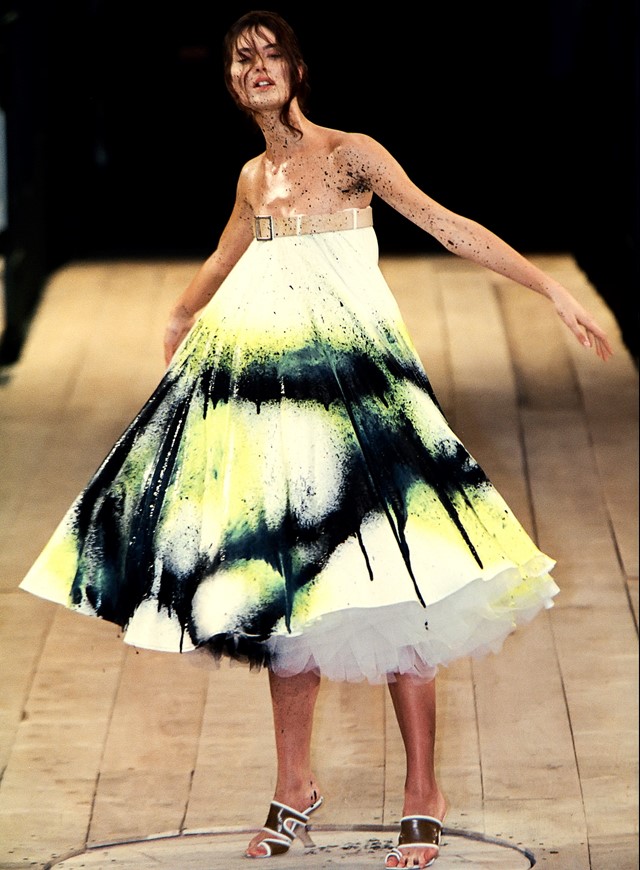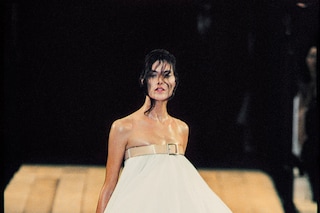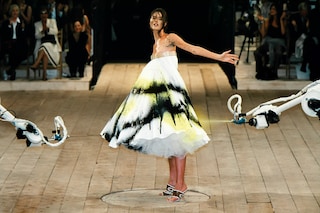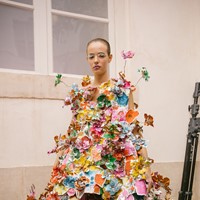As the Alexander McQueen: Mind, Mythos, Muse exhibition opens in Melbourne, Harlow reflects on her relationship with the late designer and the OG spray-paint dress that brought its audience to tears
In a London warehouse on September 28, 1998, Lee Alexander McQueen made a room full of grown adults cry. It wasn’t the first time fashion professionals had wept upon seeing McQueen’s clothes – the late designer was well known for putting on emotionally charged dramatics, and this was his 13th show – but it was the first time he agreed with the sopping sentiment on display. As he would later tell people, No. 13, as the SS99 outing was named, was “the only one that made me cry”.
Opened by Paralympian and Dazed cover star Aimee Mullins, the show featured an impressive cast of late 90s favourites, with models Erin O’Connor, Audrey Marnay, and Angela Lindvall amongst those negotiating the wooden floorboards and a pair of white robot-like machines, watched on by friends and fans such as milliner Philip Treacy and Texas frontwoman Sharleen Spiteri (Victoria Beckham, then still committed to the four-piece Spice Girls line-up, was famously denied a ticket). By the time Canadian supermodel Shalom Harlow made her final exit, approaching a round disc in the middle of the two machines, the show had already told several stories.
“There was no explanation, there was just a frock,” Harlow explains, alluding to the biggest story of them all, the moment the machines, which were more typically used to paint cars, woke up and began spraying her with yellow and black paint. Dressed in a strapless white dress of broderie anglaise, the former ballet dancer moved her body instinctively, her arms swaying in a deliberate, defensive manner: the performance has since become known as one of the industry’s most potent displays. Widely acknowledged as the blueprint for Coperni’s SS23 spray on dress moment, McQueen himself was inspired by Rebecca Horn’s 1991 installation, High Moon. “It wasn’t a fashion show. It was performance art,” Vogue wrote at the time, while Sarah Mower, revisiting the scene on the show’s 20th anniversary, described it as “A coup de théâtre, surely up there among the top ten fashion show thrills of all time.”
Twenty-four years on, the performance is one of the highlights of an exciting new exhibition at Melbourne’s National Gallery of Victoria. Following the Met’s critically acclaimed Savage Beauty and Nick Waplington/Alexander McQueen: Work in Process at the Tate, Alexander McQueen: Mind, Mythos, Muse is a rich survey of the designer’s archive which explores his boundary-pushing practice with a series of catwalk looks, art works, and photographs. “Obviously backstage you really can’t be with each piece, so to have the time to see the detail and execution of the dresses is quite beautiful,” says Harlow, the guest of honour at Saturday’s NGV Gala, which launched the show. Below, she shares her memories of working with McQueen, and what made No. 13 so remarkable.
Hey Shalom! You’re in Melbourne for the opening of Alexander McQueen: Mind, Mythos, Muse. How would you describe your relationship with McQueen, leading up to the SS99 show?
Shalom Harlow: I had worked with Lee for years and years at that point. One of the most notable things I can say, on a personal level about working with him, was how tactile he was. He was as hands on as any designer could ever be, sculpting the fabric on you, cutting, slashing, pinning – there was no head tailor, so there was an intimate interface in terms of being present. And just the degree of drama in which every show was executed was extraordinary. It was a palpable field of high theatrics every time you stepped on stage. The scope of the narrative he was telling, that became apparent throughout the course of his career, just the level at which he was communicating was so much faster than a typical designer. There were messages encoded in every collection, and that set him apart. Not to mention, the mastery of execution and the tailoring.
Have you been able to sneak a look at the exhibition yet?
Shalom Harlow: I just had a little preview and I was quite moved. I was just so touched, seeing the collection of the body of his work, and I actually got to see the man versus machine show. I had never seen that piece from start to finish, because all that’s online is edited snippets, so it was quite an emotional experience.
I read that there was no rehearsal with the machines.
Shalom Harlow: There was no explanation there was just a frock, I don't even think we'd done a fitting. I got in on a red eye that morning, so we did the dress fitting backstage an hour before the show. He explained that robot arms would come to life and spray paint the dress, and that was it. That's literally the preparation that I received. I went to the show producer and asked, “I hear I'm supposed to stand on a rotating thing, can you show me what that is?” and at that point it wasn't even actively working. What you see is me responding to stimuli, just a moment of what unfolded when put in that situation.
How did the dress feel to wear? It’s quite a front-heavy style.
Shalom Harlow: It was extraordinarily heavy. Your sense of balance is very precarious because of the weight, and the way that the weight is distributed. And then you add in the momentum of being on a rotating access and responding to stimuli coming in different directions as you try to orient and remain stable... Definitely my dance training came in handy, that's for sure.
You mentioned seeing the footage in the exhibition, and I know previously the dress was exhibited as part of Savage Beauty. Does it feel strange at all, seeing this moment that you lived, presented in a museum setting almost as an artefact?
Shalom Harlow: No, it feels appropriate to be honest. Not that I'm placing myself in the centre of that by any means, I'm just a participant in that moment. But it makes sense. I've created bodies of work with [photographer, Irving] Penn, and those are in museums as well, so it's just fortunate that I've been able to be a part of helping these masterful artists bring their vision to life. I'm kind of acclimated to it at this point, but it's definitely an honour.
A lot of people have made parallels between the McQueen show and Coperni’s recent SS23 show, where a white dress was sprayed onto Bella Hadid.
Shalom Harlow: I didn't see it, I mean I saw images of it afterwards, but I don’t have anything further to say.
On the digital hub that accompanied the Savage Beauty exhibition, you described the moment as “almost…like this aggressive sexual experience”, and referenced how it encapsulated McQueen’s thoughts about creation at the time. Can you expand on this?
Shalom Harlow: I don't want to put words on what his intention was, but from the inside there definitely felt like an aggressive, predatory sexualisation of the mechanisation of modern world and interfering with some very raw aspect of femininity, and I don't mean that as women I mean, in terms of our own internal virginal selves. This overlay of what's interjected upon all of us by the external world in this forceful, mechanised modern world that we’re meant to interface with. That’s what it felt like in the moment, that's what I was expressing.
How conscious were you at the time of the show’s impact? Did you think people would still be talking about that moment 20 years later?
Shalom Harlow: I knew in the moment that it was extraordinary, that something unique had happened. People were brought to tears, so yeah, I knew. But I don't think in terms of what a legacy may or may not be, I just don’t orient that way, so there was no forward thinking. But deservedly so people still talk about it.
And what kind of impact did it have on your own career?
Shalom Harlow: I don't know that that's something I can conceive of to be honest, I don't really have an outside perspective on that. I wasn’t plucked out of obscurity and then that moment happened, so there wasn't an impact in that way.
Head here for more information and to get your hands on tickets.







